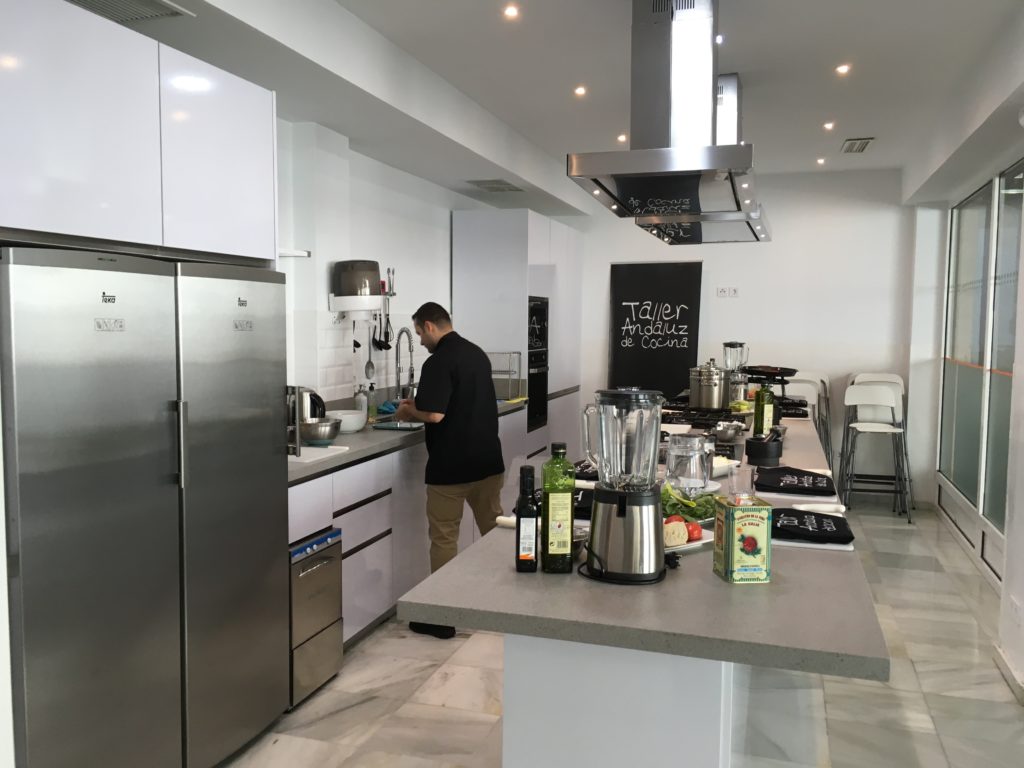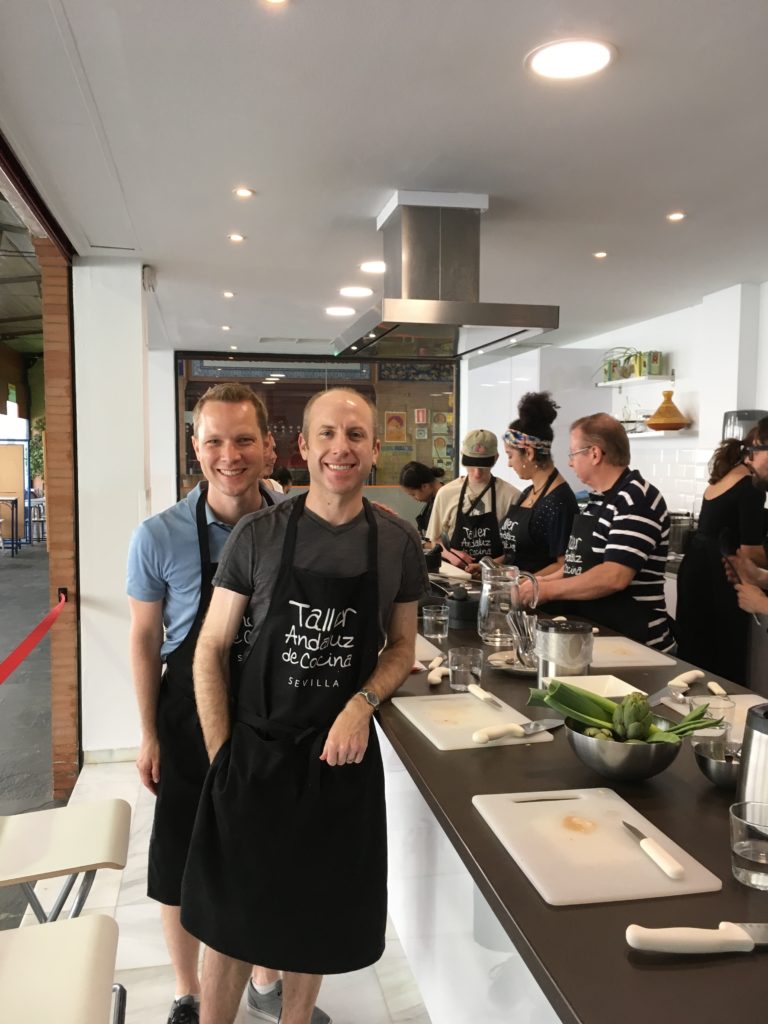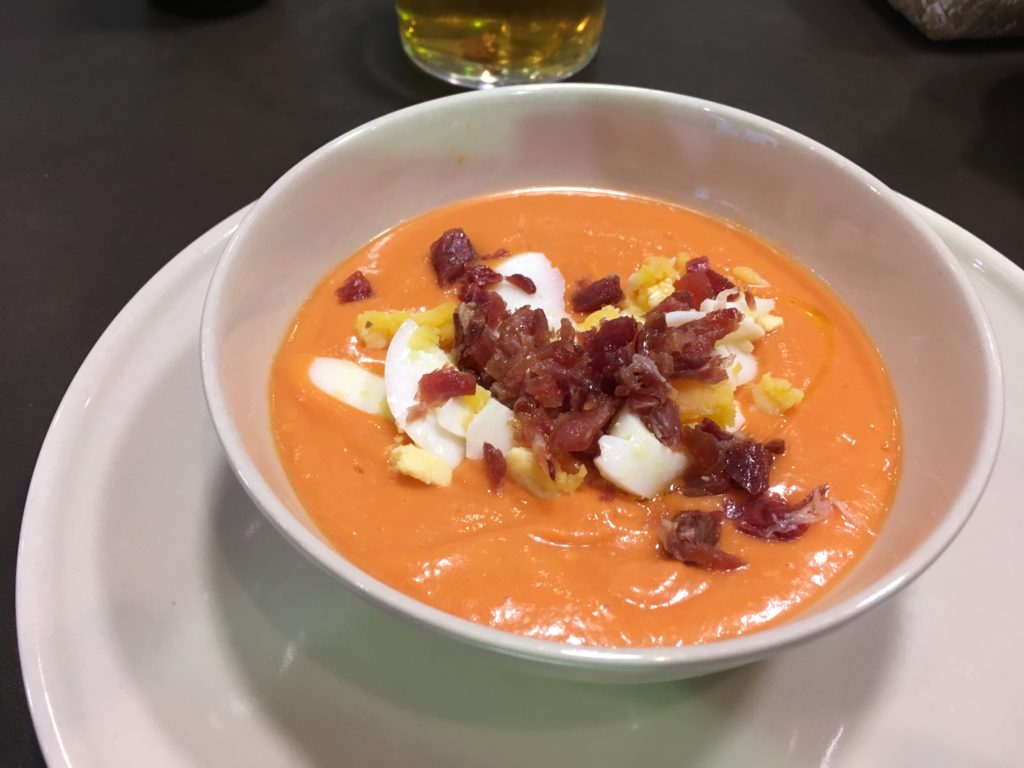Seville is known for its history, its rich culture and Flamenco dancing. But the city is also a foodie hot spot. For this part of our journey, we decided to take a break from our nightly restaurant routine to see if we could make some of our favorite dishes we’ve been enjoying along the way. That’s when I came across the highly-rated cooking school Taller Andaluz de Cocina in Seville that offers an evening paella course.

Inside the sparkling clean kitchen at Taller Andaluz de Cocina in Seville
We certainly ate our share of paella along this trip! And while we’re really good at ordering it, I wasn’t so sure that we’d actually end up with something presentable (let alone edible). The dish requires some significant work — an actual paella pan (yes that exists!), a special gas burner and patience.

We’re excited to make some food! Or maybe delegate the harder tasks to everyone else. Either way, we’ll get through it.
My favorite part of making paella? The finish. If you’ve mastered it correctly, the paella will stick to the pan even if you tilt it sideways. I imagined making it at home — and how much our dog Doug would love this experiment especially if it went wrong!

The paella settling into the bottom of the special pan
But Taller Andaluz de Cocina will take you step-by-step through the process. Located in the heart of Seville, the cooking school offers an incredibly fun night full of conversation, food and wine. Classes are kept small — with our group consisting of 10 students from around the world including the Netherlands, Venezuela, Canada and the US.

Classes are kept small, with 10 students in our group
We loved learning not just about how to prepare dishes, but why certain ingredients are used in each recipe. Chef Juan, who is a professionally-trained chef, led the class. Juan has worked over 10 years in some of the best restaurants in London and Seville. We could tell he had a strong background in food, especially compared to other cooking classes we’ve taken with teachers who just picked up cooking on their own. Juan has been in the trenches and knew his stuff!

Taller Andaluz de Cocina is located inside a local market in the center of Seville – a hot spot as the night progresses.
Follow us along our journey as Chef Juan and his team taught us how to make 3 typical Spanish dishes.
Dish #1: Salmorejo

The cool, tasty tomato dish called Salmorejo, a typical dish of South Spain
Now I’ve heard of gazpacho — the cold tomato and vegetable soup that is more liquid than soup. But I wasn’t so familiar with salmorejo before coming to Spain. But after taking the class, I began noticing it on just about every menu, especially throughout South Spain. Salmorejo is a thicker, creamier version. But surprising there isn’t any cream used what-so-ever. First step — slice up some tomatoes and blend it up, baby!

But what is the brown lump on all the tomatoes in photo above? That would be stale bread. Juan recommends soaking it in water first to help it blend. But why does it have to be stale? In short, it’s the tradition and pretty much everyone has stale bread lying around. After blending, the next critical part is the extra virgin olive oil. This is what gives the soup its thickness when there isn’t actually any cream in the recipe. So as you can imagine, you’ll be adding a lot. And when you think you’ve added enough, you add even more!

Let it rip! Adding most of the bottle of the olive oil into the blender to give the soup some thickness
Keep pouring and blending the mixture until it turns a lovely salmon color. Juan recommended using locally-produced brand Oleoestepa, which is from Estepa — a provence of Seville that produces the second highest-amount of olive oil only after Italy.

The brand of the recommended olive oil
The olive oil is available for purchase in the shop along with any other tools used in class. The recipe for salmorejo doesn’t have many ingredients beyond what we blended — just some salt, sherry vinegar (which you can substitute with apple cider vinegar if you can’t find sherry vinegar) and garlic cloves (with the stem removed). Add some boiled egg and chopped ham as garnish, and you’ve got a typical Spanish dish, perfect for the summer.

Cheers Kevin! Enjoying some traditional Sangria prepared for us (and included in our recipe packet at the end)
Dish #2: Spinach with Chickpeas

I absolutely love Indian food — and I couldn’t help but think this dish reminded me of a healthier version of palak paneer, which is often packed with heavy cottage cheese as well as thick cream and butter. You’ll find none of that in this dish. In fact, it felt really light. First step is easy, just boil some spinach.

From here, it couldn’t have been any easier. I even think I will try this dish at home. You just have to caramelize some garlic, dice and fry up some bread, add salt and spices, and you’re good to go.

The final product
The recipe serves about 6 people total and is a guilt-free, delicious meal.
Recipe #3: Paella

The key to a good paella starts with a level pan. Chef Juan carefully set up the paella apparatus and poured water inside the pan to ensure it was level. This is to ensure an even amount of heat is distributed when cooking.

The master paella set up – this looks pretty serious.
Paella got its humble start in Valencia and was a dish enjoyed by inland farmers. It was simple — a pan with rice cooked over fire. And according to Juan, the farmers would use meat left around like rabbit and lamb with whatever vegetables they had. But since most tourists don’t want to eat Bugs Bunny (a rabbit!), Juan has adjusted the recipe to include only chicken. And we’re given a detailed overview on how to carve chicken meat for the meal.

Kevin slices away at the chicken — even after a few glasses of sangria. I’m impressed!
If you’re looking at buying a pan, which they sell at the cooking school, they’re sold by the number of people planning to eat. We ended up using the massive pan for 12 people.

Kevin is slaving away in the kitchen. A rare sight indeed.
We continued cooking the dish — first starting off in the center of the pan and moving each part to the edge as we made our way through the recipe. At one point, Juan shut off some of the burners underneath as more ingredients piled inside the pan.

Saffron was another key ingredient, and we were given a tiny dish to smell and a lesson on how difficult it is to grow. Each flower only has 3 strands — which means a lot of flowers to fill up a container. We also used a rice called “arroz bomba” or short grain since it has little starch. The amount of rice you use is determined by literally piling a line down the middle of the pan.

Figuring out the quantity of rice in paella — eye balling it by piling a line down the middle of the pan
We’re getting so close, I can taste it! You just move the rice once — no more. It’s killing me! Paella is traditionally made on Sundays where families chow out of the same pan. But in our class, we would serve it individually. But the best part of making Paella is the ending — you crank up the heat for 30 seconds where you fry the rice underneath, giving it a slightly crunch texture. Time to dig in!

We did it – the verdict? The best paella yet in Spain. And we ate a lot of it.
But just when we thought we were done — we got a surprise bonus of lemon sorbet in cava (sparkling wine). Cheers to the delicious meal and an amazing class!

THE LOWDOWN:
-
Taller Andaluz de Cocina offers daily hands-on Spanish and Andalusian cooking classes, food market tours with tastings and Sherry wine tasting in Seville.
- They are located inside Triana food market with the freshest local ingredients for the best traditional Spanish and Andalusian cuisine.
- Classes are offered in English, Spanish and other languages (upon request) along with private courses.
- We took the evening Paella experience class, which is offered in the evening and 44 Euros per person or $52 USD.
- For reservations, call 34 955 31 25 74 or email: info@tallerandaluzdecocina.com
- Visit their website with more information on schedules and timing: http://tallerandaluzdecocina.com






No Comments, Be The First!